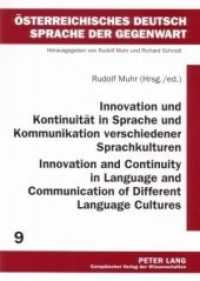- ホーム
- > 洋書
- > ドイツ書
- > Humanities, Arts & Music
- > Arts
- > theatre, ballett, film
Full Description
This monograph centres on the history of musical theatre in a space of cultural significance for British identity, namely the Theatre Royal, Drury Lane, which housed many prominent American productions from 1924-1970. It argues that during this period Drury Lane was the site of cultural exchanges between Britain and the United States that were a direct result of global engagement in two world wars and the evolution of both countries as imperial powers. The critical and public response to works of musical theatre during this period, particularly the American musical, demonstrates the shifting response by the public to global conflict, the rise of an American Empire in the eyes of the British government, and the ongoing cultural debates about the role of Americans in British public life. By considering the status of Drury Lane as a key site of cultural and political exchanges between the United States and Britain, this study allows us to gain a more complete portrait of the musical'scultural significance in Britain.
Contents
1. Introduction.- 2. Chapter 1: Cosmopolitan musical theatre styles at the Lane (1918-1934).- 3. Chapter 2: The Drury Lane Musical Theatre Spectacle (1931-1939): "Hearts Splintering in Waltz Time".- 4. Chapter 3: The Lane and ENSA (Entertainment National Services Association) headquarters (1939).- 5. Chapter 5: Rodger's and Hammerstein's Oklahoma! Carousel and South Pacific: Imported Americana.- 6. Chapter 6: Ruritanian Imperialism in The King and I (1953).- 7. Chapter 7: Fading Empire and British imitation: Lerner and Loewe.- 8. Chapter 8: Hello Dolly and the resurgence of the British musical the nostalgia of Lost Empire Word.- 9. Epilogue.








